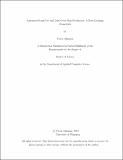Automated Land Use and Land Cover Map Production: A Deep Learning Framework
Metadata
Show full item recordAuthor
Alhassan, Victor
Date
2018-10-19Citation
Alhassan, Victor. Automated Land Use and Land Cover Map Production: A Deep Learning Framework. A Dissertation Submitted in Partial Fulfillment of the Requirements for the Degree of Master of Science in the Department of Applied Computer Science, University of Winnipeg. Winnipeg, Manitoba, Canada: University of Winnipeg, 2018.
Abstract
In this thesis, we present an approach to automating the creation of land use and land cover (LULC) maps from satellite images using deep neural networks that were developed to perform semantic segmentation of natural images. This work is important since the production of accurate and timely LULC maps is becoming essential to government and private companies that rely on them for large-scale monitoring of land resource changes. In this work, deep neural networks are trained to classify each pixel of a satellite image into one of a number of LULC classes. The presented deep neural networks are all pre-trained using the ImageNet Large-Scale Visual Recognition Competition (ILSVRC) datasets and then fine-tuned using ~19,000 Landsat 5/7 satellite images of resolution 224 x 224 taken of the Province of Manitoba in Canada. The initial results achieved was 88% global accuracy. Furthermore, we consider the use of state-of-the-art generative adversarial architecture and context module to improve accuracy. The result is an automated deep learning framework that can produce LULC maps images significantly faster than current semi-automated methods. The contributions of this thesis are the observation that deep neural networks developed for semantic segmentation can be used to automate the task of producing LULC maps; extensive experimentation of different FCN architectures with extensions on a unique dataset; high classification accuracy of 90.46%; and a thorough analysis and accuracy assessment of our results.

